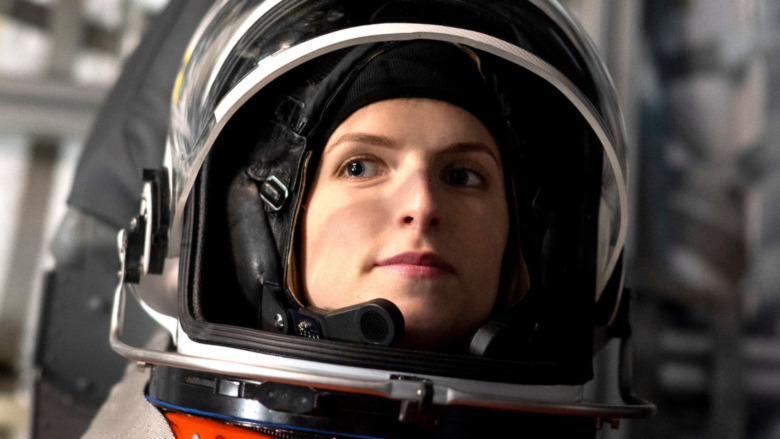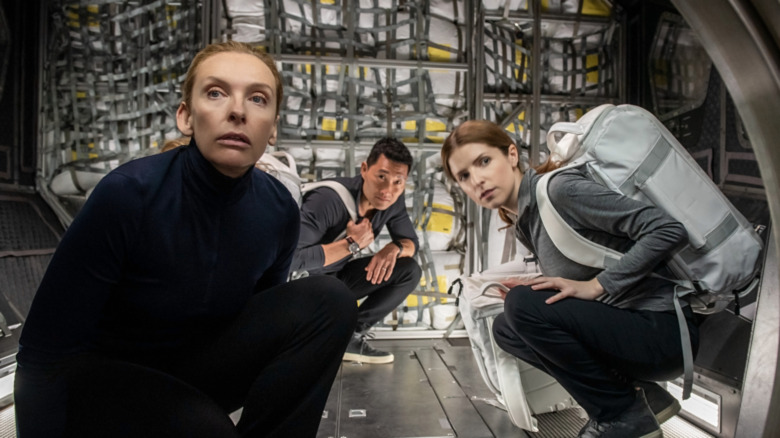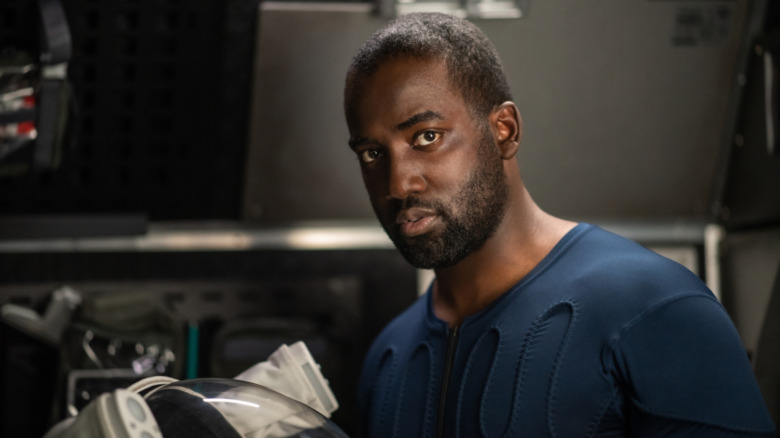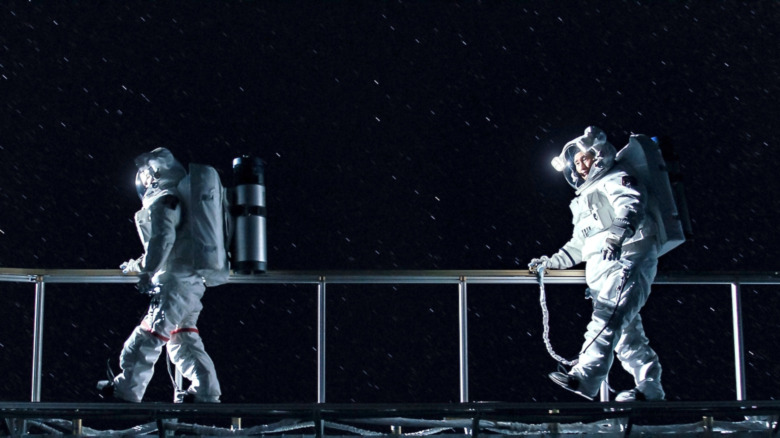The Ending Of Stowaway Explained
Netflix recently released a new science fiction drama film called "Stowaway," directed by Joe Penna and co-written by Penna and Ryan Morrison. The film stars Anna Kendrick as Zoe, a medical researcher on a spaceship bound for Mars. Alongside her are Toni Collette as Marina, the captain, Daniel Dae Kim as David, the biologist, and Shamier Anderson, known for his role on "Wynonna Earp," as the stowaway who accidentally ends up on the ship when it takes off. "Stowaway" premiered on Netflix on April 22, 2021 and earned a 77% rating on Rotten Tomatoes, with Linda Marric of New Scientist praising the film's "genuinely intriguing philosophical idea that is not only engaging, but also fantastically thought out."
At the beginning of the film, the small crew of three is just leaving Earth for a short research mission to Mars. When they discover Anderson's character Michael on board and injured after takeoff, Zoe and David tend to his wounds while Marina discovers some harrowing information. During the accident that led to his injuries, Michael accidentally damaged the CO2 scrubbers, limiting the ship's oxygen supply. With less oxygen available and two extra lungs to fill, the crew must face the question of how to survive, or if they even can.
Here's the ending of Netflix's new sci-fi drama "Stowaway" — explained.
What does the spaceship crew have to do to survive?
"Stowaway" deals with the moral quandary of what to do in a situation where it seems like the only options are that either one person dies voluntarily (or not), or everyone dies. As Michael is the stowaway who shouldn't have been on the spaceship in the first place, David tries to convince Michael to sacrifice himself for the original crew's survival. David sees himself as more important to the trip, and looking at the situation logically, he's right.
But Kendrick's character Zoe believes that there's another answer, some way they can all survive. She's also right, but it's their last chance to ensure the survival of all four people on board, and the mission is dangerous. Outside of the ship are two extra tanks storing liquid oxygen rocket propellant (LOX), and Zoe and David go on a risky mission to retrieve them. While their task starts off successfully, everything is threatened when a solar storm hits. Zoe and David race back to get in the ship with one oxygen tank before they get severe radiation, but Zoe accidentally drops it, leaving them with nothing.
Now the crew has little hope to survive, and there's still only enough oxygen left for two people. The other oxygen tank they tried to retrieve is still connected to the ship, but the solar storm is raging outside, and anyone who dares leave is essentially committing suicide. Thankfully, one person steps up to sacrifice their life for the others.
Who survives in Stowaway?
Looking her death right in the face, Zoe decides that she will be the one to go and retrieve the remaining oxygen tank and save her crew. Maybe she does this because she's the one who's been pushing to save Michael and find an alternative to the oxygen shortage, or maybe she blames herself for dropping the oxygen tank after the storm hit. While we can't know for certain why she decides to do it, Zoe takes on the responsibility of her crew's life and promises to get the job done.
Donning her space suit once again, Zoe says goodbye to David, Marina, and Michael and treks back out of the spaceship. She successfully gets the oxygen tank secured for her crew as the solar radiation starts affecting her. While the movie doesn't show Zoe die on screen, it does show the radiation as it quickly destroys her skin. In the end, Zoe sits down and accepts her death, looking out at the open abyss of space as she dies.
As for the fate of the rest of the crew, "Stowaway" doesn't reveal whether or not they survive long enough to make it back home. Hopefully Zoe's death isn't for nothing, and the remaining oxygen is enough for Marina, David, and Michael to live.
How accurate is the science of Stowaway?
While audiences should expect to see some scientific inaccuracies in a movie that takes on future space technology like "Stowaway" does, the movie is actually surprisingly factual with its theoretical science of advanced space travel. This is likely because Penna had actual experts in the field of astrophysics consult on the story.
Along with NASA and working astronauts, Penna contacted a YouTuber named Scott Manley for his help with the science in the film. Manley has a master's degree in computational physics and currently works as a software engineer at Apple Inc, but he loves studying and discussing astrophysics in his spare time (LinkedIn). Because of his continuing work on astrophysics through his YouTube channel, Manley even has an asteroid named after him (The International Astronomical Union).
In a YouTube video discussing some of the science in "Stowaway," Manley addressed the design of the spaceship, and how it was inspired by the Gemini XI gravity experiment from 1966 and the accompanying theory about creating artificial gravity (NASA). Along with that, he goes into detail about the Earth-Mars cycler that explains why the crew would be unable to turn right around and go back to Earth after finding Michael. In an interview with WIRED, Penna also explained that the fact that "there's no friction in space" makes it impossible for a spaceship like the one in "Stowaway" to simply turn around after take off, an important detail that leads to the main problem of the story.
Overall, "Stowaway" does a great job creating a realistic scenario based on current astrophysics and theories, presenting a tense and emotional drama that's both believable and moving.



